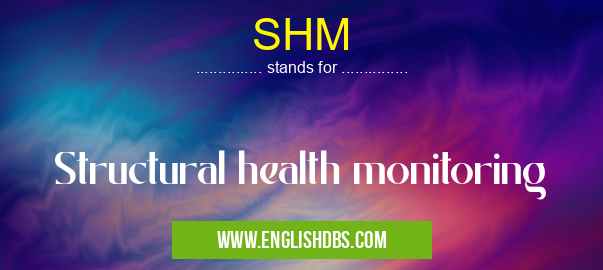What does SHM mean in CONSTRUCTION
SHM is a process of implementing a damage detection and characterization strategy for civil engineering and mechanical systems. It utilizes sensors, data acquisition systems, signal processing techniques, and computational algorithms to monitor the health and performance of structures.

SHM meaning in Construction in Miscellaneous
SHM mostly used in an acronym Construction in Category Miscellaneous that means Structural health monitoring
Shorthand: SHM,
Full Form: Structural health monitoring
For more information of "Structural health monitoring", see the section below.
- Structural health monitoring (SHM) is a process used to assess the structural integrity of a structure, typically over time.
- It involves monitoring various parameters that indicate the health of the structure, such as stress, strain, and vibrations.
Purpose of SHM
- To detect and identify structural damage or deterioration at an early stage.
- To assess the severity of damage and prioritize repairs.
- To optimize maintenance schedules and extend the lifespan of the structure.
Methods of SHM
- Strain monitoring: Measuring changes in strain using strain gauges.
- Vibration monitoring: Monitoring vibration patterns using accelerometers or laser vibrometers.
- Acoustic emission monitoring: Detecting stress waves generated by cracks or other damage.
- Non-destructive testing: Using techniques like ultrasonic testing or radiography to identify defects.
Benefits of SHM
- Improved safety: Early detection of structural damage reduces the risk of catastrophic failures.
- Cost savings: Preventive maintenance based on SHM data can save on repair costs and downtime.
- Extended lifespan: Proper structural management based on SHM can prolong the life of the structure.
- Enhanced decision-making: Data from SHM systems helps engineers make informed decisions about maintenance and repairs.
Applications
- Bridges, buildings, and other civil structures
- Offshore platforms and wind turbines
- Aircraft and spacecraft
- Medical devices and implants
Essential Questions and Answers on Structural health monitoring in "MISCELLANEOUS»CONSTRUCTION"
What is Structural Health Monitoring (SHM)?
What are the benefits of SHM?
SHM offers several advantages, including improved safety by early detection of damage, reduced maintenance costs through optimized scheduling, extended service life of structures by timely repairs, and enhanced decision-making based on real-time data.
What are the different types of SHM techniques?
SHM techniques can be categorized into three main types: vibration-based, wave-based, and strain-based. Each type utilizes different sensors and signal processing methods to detect and characterize damage.
How are SHM systems implemented?
SHM system implementation involves selecting appropriate sensors, installing them on the structure, connecting them to a data acquisition system, and developing algorithms for data analysis and damage detection.
What are the challenges in SHM?
SHM faces challenges such as sensor selection and placement, data handling and processing, environmental effects on sensors and data, and the development of reliable damage detection algorithms.
What industries use SHM?
SHM finds application in various industries, including civil engineering for monitoring bridges, buildings, and offshore structures; aerospace for aircraft structural health assessment; and mechanical engineering for rotating machinery and power plants.
What is the future of SHM?
The future of SHM lies in advancements in sensor technologies, data analytics, machine learning, and artificial intelligence, leading to improved damage detection accuracy, real-time monitoring, and predictive maintenance.
Final Words:
- Structural health monitoring is a crucial tool for ensuring the safety and longevity of structures.
- By continuously monitoring structural parameters, SHM systems provide valuable insights that help engineers make informed decisions, reduce costs, and extend the lifespan of assets.
